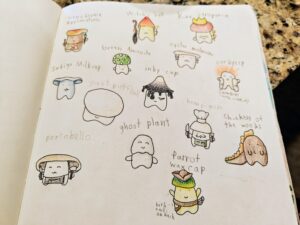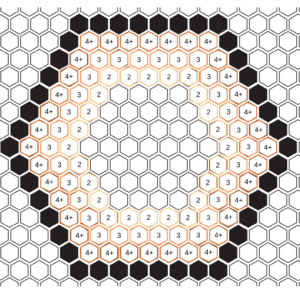Developers log, game date 20250628.4. With two games ready for production – a card game and a word game – I wanted to develop something more tactile and visually intriguing. More silly, with way more puns. I remembered these little blob creatures my kid Taren had drawn and asked if they could come up with a few different characters based on different types of mushrooms.
I went with the idea of mushrooms because of how they spread, building networks and chains of mycelia, taking over an area in a garden. I wondered whether fungi competed for resources, and it turns out they do. I got the idea of a player that would play a fungus of a particular type, and that the different fungal characters would have their own bonuses, based on the scientific characteristics of their real-life counterpart.

By the next day, Taren had come up with some concept art for the fungi. Each one had a different little style and behavior or interest, based on the type of fungi they were. It was flippin’ adorable! Just what I’d hoped. So now I had to work on the next steps: gameplay.
I envisioned a hex-grid board, where you could play up to 6 players, with each player starting in a corner so the board was divided evenly. I quickly realized there’d be a problem: dividing a hex grid for 2, 3, 4, and 6 players is easy. But it doesn’t work with 5 players. One player would always have a space advantage if they weren’t forced to interact with the other players. I considered adding a “Gardener” character: this character would not have a specific starting position, and the game would be somewhat asymmetrical: with the players competing to take over as much of the board as possible, while the gardener competed to keep as many of the hexes empty as possible. As with all the games I work on, I wrote it all down and let it marinate while I kept working on rules refinement for my other games.
Sidenote: I’m going to write a whole post about writing rules, cause I swear it’s the hardest part about game development!
The board was a simple hex grid. I wanted a large board so we could fit up to six players. But as I started placing all these hexes, I realized something: the larger the board, the more pieces a player would need. Also the few players, the more empty space there would be! A board with 7 hexes per side gives you 127 hexes. For a 2-player game, that means you’d need a minimum of 64 playing pieces. Since I wanted to have mechanics that would also remove pieces from a player’s pool, that meant even more pieces. So… that wasn’t going to work. Especially since you’d need the same number of pieces for each player color.
For a 4-player game, that number drops dramatically, down to an average of 32 spaces/player. I wanted two different types of pieces: spore colonies – these would act like bases where a player could spread from, and mycelial tiles – these would be the spreading pieces of their chains. With 3 colonies and 40 pieces, a 4-player game could fill the board, even if players lost pieces during a game.

That gave me the average pieces, but how would I get it to work with fewer players, or more? You could have players count out a bunch of small parts, but the easier thing to do would be to make the board itself adjustable. My first idea to do this was to make flat blanking pieces that you’d lay over the board. But this was hard to do in a way that didn’t make them slide around and feel cumbersome. Next I thought about pieces of cardboard “fences” that would have notches in them, and you’d put them together like craft sticks. Each notch would indicate whether you were playing a 2, 3, or 4+ player game, and would essentially change the board size. That’s still the current idea, but I haven’t actually build the fence pieces yet. Instead, I just colored the borders of the hexes and added numbers to outline the board for each player count.
Now that I had a board to play on, I used Canva to create colored hex “tiles” and began playing through some basic games. I needed to get a feel for how players would put pieces on a board in a fair manner, but that would also create natural gaps in the board that opponents could fill. If the pieces were placed too close together, you could create a solid wall of pieces that prevented interaction.
After 10 or so playthroughs with 6, 4, and 3 players (was still thinking about the 5-player game) I had the following worked out:
- Placing up to 4 tiles per turn made for a decent fill rate.
- Came up with some rules on tile placement that forced gaps in the board, without being too complicated to remember.
- Decided that if we did more than 4 players, we’d have to reduce placement from 4 tiles to 3. But still hadn’t figured out that 5-player issue.
For now I decided I’d still with 2-4 players, print out a board, and start getting a literal and figurative feel for the game play.